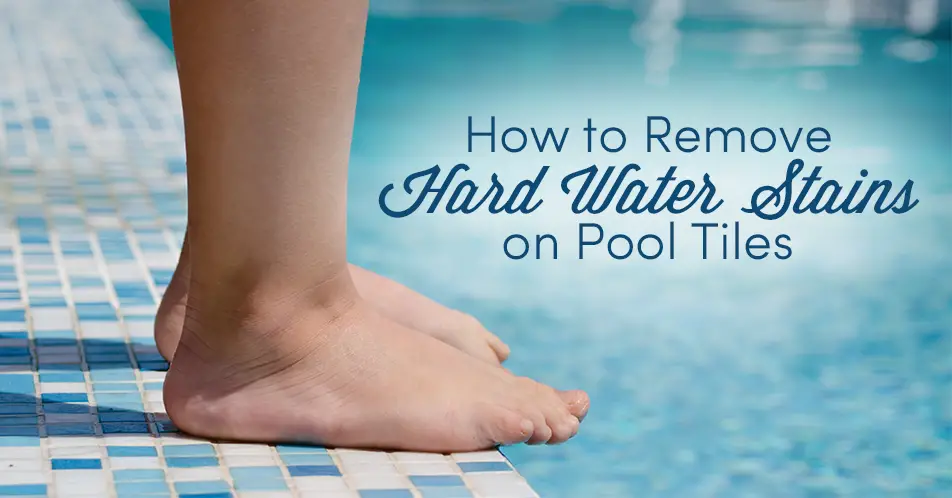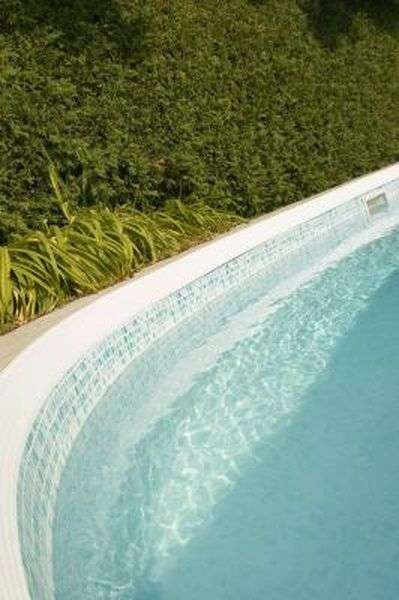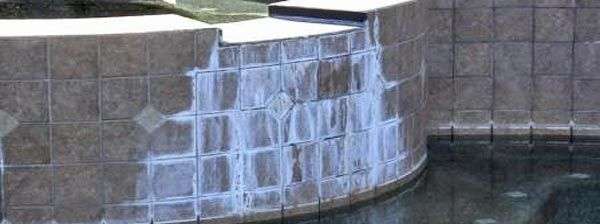Hire A Professional Bead Blaster
If removing the pool scale doesn’t work with the methods we’ve already listed, you probably have a severe case of pool scaling that needs professional attention.
You can hire a professional pool company to come to your pool to remove the calcium. This process is called bead blasting and is sometimes called pressure washing.
This service is different than how you would use a pressure washer to wash your car. Professional companies use a compressor to blast sand, beads or other materials at the pool tile at high speed.
This scrapes away the buildup quickly. And you don’t have to spend time scrubbing the tile yourself.
Most companies use magnesium sulfate to blast the calcium off your pool tiles.
Note, this option can be very expensive. Ideally, you want to remove calcium buildup on your own. And practice good pool maintenance to prevent pool scaling in the future.
Option : Tile Cleaning Products And Stain Erasers
Youll find cleaning products sold specifically for cleaning pool tile. To rid your tile of calcium buildup, look for stain erasers made from soft abrasives that remove the hard substance from your tile. For concrete pools, you can use a wet pumice stone on the wet tile for a similar effect. Other tile cleaning products are chemical-based and can dissolve calcium scale or buildup when applied directly to the dirty tile. Check your pool supply store for specialized products.
How Often To Clean Pool Waterline Tiles
For the easiest maintenance, the waterline tiles should be cleaned as soon as you notice any discolorationweekly or monthly. Small levels of build-up at the waterline are much easier to clean than waiting until it is heavy. The tiles should always be cleaned at the beginning and end of the pool season.
You May Like: How To Repair Cracks In Concrete Pool Deck
How To Remove Calcium Deposits From Swimming Pool Tiles With Muriatic Acid
Muriatic acid is an acid that is hydrochloric-based and makes an excellent limescale remover. Muriatic acid washing is powerful, so we recommend wearing protective goggles and rubber gloves.
To efficiently eliminate hard water stains on tile, utilize the powerful ingredients in muriatic acid, which eat through limescale.
Combine one part muriatic acid with eight parts water in a large spray bottle. Spray the acid wash on the affected areas and let it sit for five minutes. With a nylon brush, continue scrubbing the limescale buildup until it is clean.
Finish your tile cleaning by rinsing the area with clean water. If you have to remove limescale buildup in your home, like a toilet or shower, consider using muriatic acid.
How To Clean Hard Water From Your Swimming Pool Tiles

Caring for a swimming pool can be tough work, but it must be done if you want the best experience out of it. Getting the best means you’ll enjoy all of the amazing benefits pools can offer: relaxing outdoor fun, a beautiful environment, and great exercise. One of the top ways a pool can be less enjoyable than it should be is by allowing it to slowly decline in appearance. However, this isn’t usually permanent. One example is hard water stains. You can clean these tough and ugly stains from pools in Cumming if you follow these 6 steps:
1. Remove the water. You must drain your pool at least 12 inches below the level of the tiles or drain it completely if you have a tiled floor. A pool service company can help you drain your swimming pool.
2. Buy a certified tile cleaner. It should be made of gel and be strong enough to remove stains without damaging tile, staining the grout, or leaving behind harsh chemical residue.
3. Apply the cleaner to the tiles with a cloth, being sure to provide total coverage to every tile. Imagine that you’re painting the pool with the cleaning gel.
4. Let the gel sit for about 15 minutes to take action against the hard water stains–a buildup of minerals in the pool water. Try not to disturb it while it’s working hard to remove the mineral buildup.
5. Use a damp rag–dampened with water from the tap, not the pool itself–or a brush to rinse off the tiles. You may want to give your tiles a second rinse to ensure all the gel has come off the tiles.
Recommended Reading: Mandalay Bay Pool Season
Prepare Your Cleaning Solution
Fill your bucket with a gallon of water. Pour 8 ounces of muriatic acid into your measuring cup, then slowly pour that acid into the water. Always pour acid into water instead of the other way around, because acid is more likely to splash out the other way. Another thing to keep in mind is that you want to pour slowly, because mixing the two together can produce heat, causing the mixture to boil.
Option : Muriatic Acid
If vinegar or store-bought cleaning products dont work, the next step is to use a mixture of muriatic acid and water. You will find muriatic acid at your local pool store. Be sure to wear gloves and be careful when using the acid because it can cause burns and irritation if it comes in contact with your eyes or skin.
Read Also: How To Remove Stains From Pool Walls
Natural Cleaners Are Great For Pool Tiles
Natural cleaners work well if you have a minimal amount of scum. This is another reason why its better to keep up with pool tile cleaning and prevent too much grime build-up. Natural cleaners such as baking soda, toothpaste, or vinegar all gently abrase pool tile surfaces. Try using a little bit of these cleaners, or more gentle household products like dish soap or Borax, and a toothbrush around the waterline of your pool. These cleaners will not throw off your pools pH levels.
Leslies Stain And Scale Prevent
Our chemists took our popular Leslie’s Stain and Scale Remove, mentioned above, and added a sequestering agent to control minerals and metals. Leslies Stain and Scale Prevent keeps both locked in solution with strong molecular bonds. This powerful pool descaler even controls high levels of calcium and silicates while actively dissolving films and deposits. Its a one-step proprietary blend of polymers to remove and prevent pool stains. Just apply once per month to a clean pool with good water balance.
Read Also: How To Vacuum Pool Without Skimmer
How Do You Get Hard Water Stains Off Pool Tile
Clean Pool Tilescleaningcalcium from pool tileswatercleaning
. Similarly, it is asked, how do you remove hard water stains from pool tile?
Put on your gloves and goggles, and douse one sponge with hydrochloric acid. Lightly wipe the tiles to loosen the calcium buildup. Let sit for 3-4 minutes to allow the hydrochloric acid to soak in. With gloves and goggles still on, take the clean sponge and wipe down the area to remove the calcium.
Similarly, what causes calcium build up in swimming pools? Scale deposits can form along the waterline of your swimming pool. This is usually caused by either high pH, high alkalinity, or a high calcium concentration. Constant temperature changes along with rapid evaporation will cause deposits to settle along the side your pool wall.
Moreover, how do you remove calcium deposits from pool tile?
If your pool has calcium carbonate deposits, you can remove them with a pumice stone, stain eraser or scale remover. A pumice stone should only be used on hard surfaces, such as tile and concrete. Simply use the stone to scrub the deposits.
How do you remove hard water stains from a fountain?
Soaking some vinegar water around the white scale and using a mild abrassive scrub pad will start to break down the deposits and remove them. You can also try CLR , commonly used to clean bathroom showers and such.
Know The Causes Of Stains And Scaling
Just like in your sink or tub, your pool can develop hard water stains. This is from calcium deposits caused by water evaporating. Both calcium carbonate and calcium silica can cause scaling. A pumice stone is a good tool to use to remove the calcium deposits.
Staining can be caused by a chemical imbalance in the water. The tiles at the waterline, where the tile meets the level of the pool, are prone to getting stained and dirty. Keep an eye on your chemical levels, and test them weekly. Too much chlorine in the pool often causes discoloration of the tiles.
You May Like: How To Get Wasps Away From Pool
Does Clr Remove Calcium From Pool Tile
Calcium Scale can be removed with muriatic acid, or dry acid dissolved in water. Acid Magic or Instant Liquid Acid or even pH Decreaser can also be used as a safer acid to remove scale. Do not use CLR or household cleaners to remove pool scale however, which add chemicals that dont belong in your pool.
What Causes Scale In Pools

Calcium carbonate scale can form along the waterline of the pool as evaporation increases during the summer. Scale itself is a white translucent color, but is often mixed with dirt and algae to appear darker.
Calcium crystals can form as nodules dotting the surface of the pool, or on ladders and light rings, or as crusty deposits in corners. Minerals like calcium commonly form sheets of scale, covering the entire pool surface in a thin layer.
The most common cause of calcium scale in pools is the result of high calcium hardness, over 400 ppm, yet is triggered by high Alkalinity, high pH and high water temperatures. Some will tell you to drain the pool if over 400 ppm, but not necessarily!
The best way to control for the various elements leading to pool scaling is to perform a regular test known as the Langelier Saturation Index, or LSI for short. An LSI test determines a pools preponderance for scaling or etching. A pool is considered to have a balanced LSI when results are -0.3 to +0.3. Test results below -0.3 indicate a prevalence toward corrosion and above +0.3 and your water is scale-forming.
The math is a bit complicated to calculate the LSI, but you can use the Pentair LSI Tool just plug in your water test levels and it crunches the numbers for you! The tool is then used to see the effect of adjusting chemical levels.
Recommended Reading: How Big Is La Fitness Pool
Swimming Pool Stains Removal Guide
For some pool owners, a stained pool is beyond embarrassing, worse than tattered carpet and stained couch cushions. It can ruin your entire backyard experience. Hard-to-remove pool spots and stains can take a bit more than just brushing. You need some powerful methods to treat and prevent pool stains.
The first step to getting rid of those eyesore spots is to diagnose the stain type. Swimming pool stains can be caused by:
1. Metals or Minerals in the pool water coming out of solution2. Rust coming through the wall, floor, or around fittings3. Organic material like leaves, dirt, oils, worms or algae
A clue to identifying the type of pool stain may be found in the color of the stain.
Pool Stain Identification:
First of all, you should determine if the stain is Organic or Metallic.
Many people think that their pool plaster is stained, when they really just have an algae problem. If the stain brushes off, even slightly, or responds at all to shocking or sprinkling granular chlorine over it, then what you most likely have is an algae bloom. Visit our Pool Info page for more information on how to treat pool algae.
Mottling: Sometimes, you will not have a stain at all, but just normal mottling of the plaster. Remember that plaster is a natural product and is subject to variations in hue and shading. Streaks or mottled effects are considered natural, and they cannot be removed.
How To Prevent Calcium Scale
Most calcium scale is caused by water chemistry interactions that can be avoided or circumvented by using several of these calcium scale prevention methods.
- Use a sequestering agent to keep calcium locked up in solution, so it cant precipitate into scaly deposits. Chemicals such as Stain Away or Scale Free sequester metals and minerals. But, only if you apply the regular maintenance doses every week or two.
- Avoid calcium hypochlorite shock, which adds calcium to the pool. Use a non-chlorine oxidizer, or di-chlor pool shock.
- Lower your pH and Alkalinity on the low end of the scale a pH of 7.2-7.4 and Alkalinity of 80-90 ppm. High pH and Alkalinity create ideal scaling conditions.
- Compute your LSI, a formula that computes your waters propensity to scale. Negative results below 0.0 are best to avoid scaling. Pentair LSI calculator does the math for you.
- Use a clarifierto seek out calcium particles and clump them together so that your pool filter can remove.
- Brush your pool often to remove newly formed scale, and vacuum or run the pool cleaner several times per week to remove calcium dust and dirt.
Recommended Reading: Liquid Chlorine Pool Calculator
How To Clean Pool Waterline Tile
The faint line around your pool helps to signal when to fill it, but its also an eyesore. Next time the pools water level drops, grab your cleaning supplies.
4 easy steps to clean pool waterline tile:
- Wet the tile and a pumice stone
- Scrub gently to remove the first layer of buildup. Make sure not to scratch the tiles with the pumice stone
- Apply a calcium releaser according to the directions
- Continue to scrub lightly if needed
Use gloves and eye protection when working with calcium releaser. You may need to repeat the process, and the releaser can irritate the skin.
How To Remove The Harsh Water Stains
The method you use to tackle the stains will depend on the nature of the calcium buildup. If its merely calcium carbonate, you can scrub clean with a brush or stone. However, if the accumulation consists of calcium silicate, you may need to use harsh chemical cleaners.
The Spruce states that approximately 36 percent of children between the ages of 7 and 17 years, and about 15 percent of adults in the United States, go for a swim at least six times in a year. With such a statistic, it becomes even more critical to ask pool builders near me to keep your pool clean.
Here are the top three ways to get rid of these harsh water stains.
Recommended Reading: Inground Salt Water Pool Cost
The Perfect Time For Pool Tile Cleaning In Henderson
In Henderson, Nevada, we have hard water. Most likely at some point, youll see a build-up of calcium along the waterline of your pool, or perhaps on the edges of a spa over the spillway. That indicates time for pool tile cleaning.
Often people will ask us when we brush each week, why is there still a white residue left. The brushing we do for our weekly service is to get the dirt and loose debris off the walls, and wont address the calcium/hard water issue.
There are 3 ways to deal with the calcium and hard water stains on your pool:
Its a great way to get your tile looking almost brand new. After that, wed recommend a regularly scheduled chemical product application to prevent future build-up problems. Overall, pool tile cleaning protects your investment and offers years of backyard entertainment for you, your family and friends.
Pros And Cons Of Using A Pumice Stone
A pumice stone is a popular tool for pool cleaning and breaking down calcium deposits. Because pumice stones have a rough exterior, they are great for scrubbing through calcium silicate.
Additionally, pumice stones are inexpensive and easy to find. Although pumice stones are useful for cleaning pool tiles calcium deposits, there are some cons to using this pool tile cleaner.
Before using a pumice stone to clean tile surfaces, there are a couple of things to keep in mind. One aspect includes the length of time it takes to clean a surface.
Pumice stones wear out relatively quickly and are not the fastest method to remove limescale buildup. Also, pumice stones may damage tiles by scratching the surface.
Read Also: Cost To Acid Wash Pool
How To Clean Stubborn Buildup On Pool Tiles
Sometimes a pumice stone alone cant clean pool tile with calcium buildup. Old calcium deposits have layers that take a week to chip away by hand.
For the stubborn calcium, try adding a nylon brush to your drill. Use the drill brush paired with a calcium releaser for the best results. The brush may damage any fragile tile, so test it in a hidden corner first.
If this is the case, its likely the time to call in a professional pool care, cleaning and maintenance company. You do not want to scratch those beautiful tiles.
Safely Dispose Of Unused Acid

Contact your local pool supply business or municipality to learn how to dispose of any unused muriatic acid. Do not simply throw it away or pour it down a drain.
Because muriatic acid is so much stronger than vinegar or the other cleaning agents mentioned above, it can remove calcium deposits that are much more advanced. That being said, with deposits that have been growing and hardening for a long time, sometimes not even muriatic acid is enough.
If thats your situation, you have two remaining options: a pumice stone and a lot of elbow grease, or pressure washing.
Since we already spent time on the intense nature of cleaning with muriatic acid, we will skip the pumice stone method to give you a break and talk about pressureor beadwashing.
Recommended Reading: Intex Pool Chlorine
